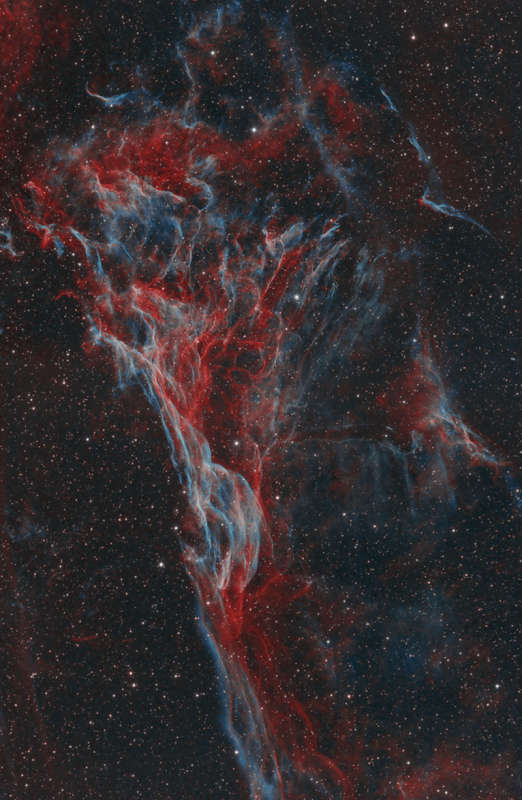Credit & Copyright: Sara Wager
Explanation:
Chaotic
in appearance,
these tangled filaments of shocked, glowing gas are spread across
planet Earth's sky toward the constellation of Cygnus as
part of the Veil
Nebula.
The Veil Nebula itself is a large
supernova remnant, an expanding
cloud born of the death explosion of a massive star.
Light from the original supernova explosion likely reached
Earth over 5,000 years ago.
Blasted out
in the cataclysmic event, the interstellar shock waves
plow through space sweeping up and exciting interstellar material.
The glowing filaments are really more like long ripples in a sheet seen
almost edge on, remarkably well separated into
the glow of ionized hydrogen atoms shown in red and oxygen in blue hues.
Also known as the Cygnus Loop, the
Veil Nebula now spans
nearly 3 degrees or about 6 times the diameter of
the full Moon.
While that translates to over 70 light-years
at its estimated distance of 1,500 light-years, this field
of view spans less than one third that distance.
Often identified as Pickering's Triangle
for a director of Harvard College Observatory, the
the complex of filaments is cataloged as NGC 6979.
It is also known for its discoverer,
astronomer
Williamina Fleming, as
Fleming's
Triangular Wisp.
1999 2000 2001 2002 2003 2004 2005 2006 2007 2008 2009 2010 2011 2012 2013 2014 2015 2016 2017 2018 2019 2020 2021 2022 2023 2024 2025 |
Yanvar' Fevral' Mart Aprel' Mai Iyun' Iyul' Avgust Sentyabr' Oktyabr' Noyabr' Dekabr' |
NASA Web Site Statements, Warnings, and Disclaimers
NASA Official: Jay Norris. Specific rights apply.
A service of: LHEA at NASA / GSFC
& Michigan Tech. U.
|
Publikacii s klyuchevymi slovami:
supernova remnant - ostatok Sverhnovoi - Veil Nebula - tumannost' Vual'
Publikacii so slovami: supernova remnant - ostatok Sverhnovoi - Veil Nebula - tumannost' Vual' | |
Sm. takzhe:
Vse publikacii na tu zhe temu >> | |
